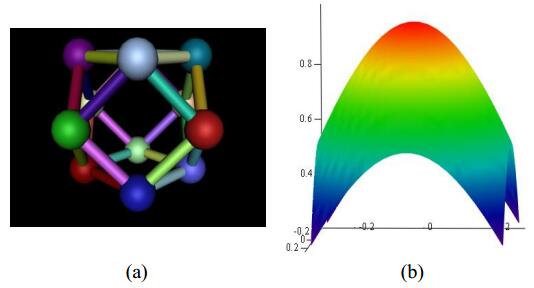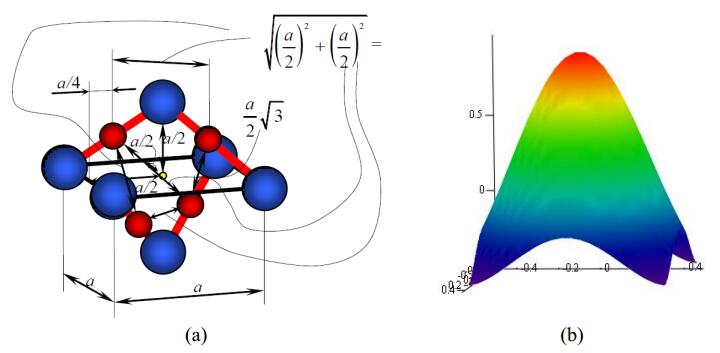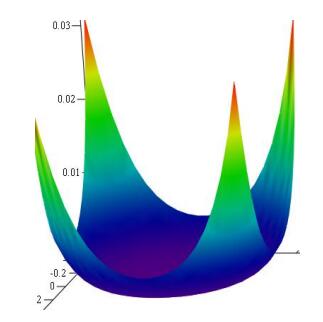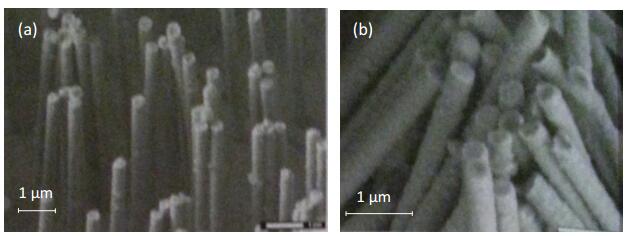1. Introduction
The production of metallic and semiconductor nanotubes by various methods is becoming increasingly important. Modern methods used to design ultra-thin tubes include: spin coating and injection molding, thermal deposition, step-by-step assembly, chemical self-assembly, various computer simulation techniques. Of particular importance is the computer simulation of various nanostructures, on which the greater part of the technology for obtaining nanocrystalline materials depends. At the same time, it should be noted that the structure and properties of nanocrystalline materials in computer simulation depend on different sets of given initial modeling parameters.
The study of the structures and geometry of neutral and charged atomic clusters uses different methods: the non-empirical Hartree-Fock method (HF) and the second-order Möller-Plesset method. To study the dependence of the composition on the physical properties of small and medium clusters, a combination of the first principles of computing electronic structures and semiempirical methods is used. The process of cluster formation in a nanostructure is accompanied by a discontinuity of symmetry, which can be identified according to the specific structure of the cluster [1]. For clusters of several atoms (~5) molecular dynamics based on semi-empirical methods (MOPAC PM3) was used before the quantum-mechanical calculation.
Semiconductor crystal calculations are carried out using the projector method of the coupled wave of the plane wave pseudopotential and the generalized gradient approximation (GGA) for the exchange-correlation energy. Geometric optimization and preliminary calculations are performed using the GAUSSIAN package of various versions with a basic function set and the core electronic effective core potential (EPO) ECP10MDF35 [2,3,4,5,6,7,8].
As shown by the analysis of literature data, a so-called template synthesis, which includes the direction of studying the processes of formation and practical application of ion tracks, is assigned a special place among the methods currently being developed among methods of obtaining various morphologies and properties of nanostructures in solids. This technique is based on a unique phenomenon when high-energy heavy ions induce a very narrow latent track containing a highly disordered zone with a diameter of about 5–10 nm [9,10,11,12].
2. Materials and method
In the calculation method used, the results are shown in three-dimensional reciprocal space, and the summary data are given in the corresponding tables. The calculations were carried out using the screening method of the pseudo potential and finding the polynomial solution of the Schrödinger equation for the energy in the space of wave vectors. A polynomial solution for energy is taken such that it fits up to several eV, depending on the system. Nanoparticles are placed in a cube with concave sides up to 20 Å with periodic boundary conditions. The atomic structure is completely idealized without any deviations, while the absolute value of the force acting on each ion becomes less than 0.005 eV/Å and the energy as a result converges within an error of 0.0001 eV. Integration of the Brillouin zone is performed using only the point G. The configurations of the valence electrons for (Cu)n are chosen so that the state s2p1 (s2p3) is present.
3. Results
Figure 1a shows the optimized structure of a cell with one electron (Cu)n with n = 6, 12. Table 1 shows the calculated electron density [13] in the interspheral space, the electron avulsion of the highest occupied atomic orbital level and the transition to the lowest free interspheral space and the energy difference empty and three-dimensional filled cells of (Cu)n nanoparticles. Figure 1b shows the electron density values, listed in Table 1. For n = 12, the cell occupied by an electron has a high stability with cubic symmetry (as for Cu2O), which is shown in Figure 2 [14,15,16] (We also have a spontaneous ordering, but with Cu2O. See also for GaAs [17,18,19,20]). There are two types of coupling, namely, the short-range exchange coupling (1.87 Å) of hexagonal bonds, which have a binding character sp2 to a greater extent, and the exchange of relatively long-acting (1.95 Å) bonds of a hexagon with a rhombus having the nature of the sp3 bonds. The variation of valence angles and bond lengths for various metal-gas compounds appears. It is found that the cells of copper–oxygen nanoparticles are more concave because of the strong character of sp3 compared to the (Cu)n cells, as can be clearly seen from the comparison of the Cu2O cell in Figure 2a with the cell (Cu)n in Figure 1. The first is more concave.
Table 1. The electron density in the interspheral space of a cell with one electron (Cu)n n = 12.
| kx, Å |
ky, Å |
ρ, Å−2 |
| −0.276 |
−0.276 |
0.225 |
| −0.246 |
−0.246 |
0.414 |
| −0.236 |
−0.236 |
0.534 |
| −0.226 |
−0.226 |
0.561 |
| −0.216 |
−0.216 |
0.489 |
| −0.206 |
−0.206 |
0.333 |
| −0.196 |
−0.196 |
0.414 |
| −0.186 |
−0.186 |
0.636 |
| 0.186 |
0.186 |
0.775 |
| 0.196 |
0.196 |
0.806 |
| 0.206 |
0.206 |
0.723 |
| 0.216 |
0.216 |
0.541 |
| 0.226 |
0.226 |
0.534 |
| 0.236 |
0.236 |
0.775 |
| 0.246 |
0.246 |
0.926 |
| 0.276 |
0.276 |
0.959 |
For (Cu)n and Cu2O, the three-dimensional filled cell with respect to the electron density lies higher than the empty one [21], and so all the nanoparticles of the metal and semiconductor-cuprite with n = 16 indicate in favor of the empty cell of the structure (Figure 2a), but the energy difference between empty and filled cells decreases (see also Table 2).
Table 2. The electron density in the (Cu2O)n interspheral space cell.
| kx, Å |
ky, Å |
ρ, Å−2 |
| −0.468 |
−0.468 |
−0.447 |
| −0.458 |
−0.458 |
−0.448 |
| −0.448 |
−0.448 |
−0.392 |
| −0.438 |
−0.438 |
−0.323 |
| −0.428 |
−0.428 |
−0.255 |
| −0.418 |
−0.418 |
−0.2 |
| −0.408 |
−0.408 |
−0.167 |
| −0.398 |
−0.398 |
−0.162 |
| 0.398 |
0.398 |
−0.184 |
| 0.408 |
0.408 |
−0.232 |
| 0.418 |
0.418 |
−0.296 |
| 0.428 |
0.428 |
−0.366 |
| 0.438 |
0.438 |
−0.429 |
| 0.448 |
0.448 |
−0.47 |
| 0.458 |
0.458 |
−0.448 |
| 0.468 |
0.468 |
−0.377 |
Cu2O has a full filled shell, so that it is impossible the existence of the phase instability for the charge transferring. X-ray phase analysis of Cu2O films obtained by chemical deposition showed an identity with a single-phase composition of polycrystalline cuprous oxide Cu2O obtained by high-temperature oxidation. On the other hand, in the three-dimensional filled cell (Cu)n and (Cu2O)n, as shown in Figure 2b, the positions of all the peaks are preserved, but their intensities have sharply decreased. The most intense intensity peaks of (Cu)n were of the order of ρ = 1027–1031, and for (Cu2O)n, they were 1–1.5. The difference between the energies (Cu)n between the filled cells n = 6 and 12 is, however, only 0.186 eV. In the interspheral space (Cu2O)n n = 16 in the filled cells, there are two oxygen atoms inside the cell that is bent with a more sp3-binding character. Central ions O and Cu2 bind well in a cell with two 2 ions of O, in the cell, the O ions are optimally connected [13]. Here (Cu2O)n also has the largest discontinuity from the uniform increasing of nanoparticles and the optimality decreases for these limits (see Figure 3 and Table 3).
Table 3. The electron energy in the (Cu2O)n interspheral space cell.
| kx, Å |
ky, Å |
E, eV |
| −0.468 |
−0.468 |
0.133 |
| −0.458 |
−0.458 |
0.06 |
| −0.448 |
−0.448 |
0.028 |
| −0.438 |
−0.438 |
0.015 |
| −0.428 |
−0.428 |
0.01 |
| −0.418 |
−0.418 |
9.465 × 10−3 |
| −0.408 |
−0.408 |
0.012 |
| −0.398 |
−0.398 |
0.022 |
| 0.398 |
0.398 |
0.045 |
| 0.408 |
0.408 |
0.099 |
| 0.418 |
0.418 |
0.06 |
| 0.428 |
0.428 |
0.021 |
| 0.438 |
0.438 |
7.54 |
| 0.448 |
0.448 |
3 × 10−3 |
| 0.458 |
0.458 |
1.627 × 10−3 |
| 0.468 |
0.468 |
1.463 × 10−3 |
The structure of the (Cu)n cell with n = 6 and 12 shows an important sp2 bond with less deformed ones (see Figure 1 for (Cu)n), analogous to cells n = 16 and 23 for (Cu2O)n. However, for (Cu)n and (Cu2O)n, empty cells are deformed more and develop a more significant bond sp3. This is why filling the cell is more appropriate in these cases, as shown in Figure 2. There is a large decrease in the electron density ρ (see the Table 3) for n = 23, and this shows that the tendency of the structure of the filled cell becomes much stronger than the case of n = 16.
Thus, for n = 12, an increase in the electron density and an energy decrease of 0.1 eV for (Cu)12 arise in a three-dimensional filled cell. Moreover, (Cu2O)16 shows a remarkable transition to the three-dimensional structure of a filled cell with the highest electronic density ρ (Cu2O)23 and a large discontinuity in the exchange bonds of lengths 1.87, 1.90, and 1.92 Å compared to n = 16.
4. Discussion
Using the modeling method described above, we obtain the geometry of Cu nanotubes. The results of the simulation of Cu nanotubes gave their dimensions with averaged dimensions of 10 μm in height, 378 nm in outer diameter, 181 nm in internal diameter, and a wall thickness of about 101 nm. The elemental composition of such nanotubes is 95–98% composed of Cu and 2–5% oxygen. Nanotubes obtained by chemical synthesis correspond to the predicted geometric characteristics (see Figure 4). Energy-dispersive analysis was used to determine the elemental composition of Cu nanotubes.
Electrodes for electro-chemical operations are aluminum or copper. In the course of experiments with Cu2O, it becomes possible to grow such nanotubes.
5. Conclusions
The electron density and the energy include a number of peaks, which corresponds to the transition of the electron to the interspheral space in the cluster. This minimum binding energy corresponds also to the infinite energy of the electron. The peaks are associated with the transition of the electron to the excited neutral state of the cluster, processes of electrons transition from certain shells to the interspheral space.
Conflict of interest
The authors declare that there is no conflict of interest regarding the publication of this paper.










 DownLoad:
DownLoad: 









